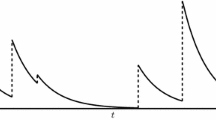Abstract
A semi-Markov model describing the performance of an ATM multiplexer with VBR video sources as inputs is presented. The considered system consists of the bit-streams generated by a collection of these sources. The streams which are first separately packetized into fixed size cells, and then, through a statistical multiplexer, join a common queue (assumed to be infinite) where they are served on a FIFO basis by a constant capacity channel. The model to be used is based on the assumption that the video sources operate in two bit-rate modes with unequal average holding times. Each video source is decomposed into an aggregate of two types of ON/OFF mini-sources. Multiplexing a number of such sources leads to a semi-Markov process, which is defined and solved using a phase process with as states the number of active mini-sources of each type. By relating an embedded Markov chain to this phase process, a solution to the resulting queueing system is presented, and the queue length distribution is derived using matrix–geometric techniques. Lastly, results are presented showing that the system performance depends not only on the ratio of the average holding times in the two modes, but also on their magnitudes.
Similar content being viewed by others
References
A. Adas, Traffic Models in Broadband Networks, IEEE Communications Magazine 35(7) (1997) 82–89.
R.G. Addie, M. Zukerman and T.D. Neame, Broadband traffic modeling: Simple solutions to hard problems, IEEE Communications Magazine 36(8) (1998) 88–95.
A. Arulambalam, X. Chen and N. Ansari, Allocating fair rates for available bit rate service in ATM networks, IEEE Communications Magazine 34(11) (1996) 92–100.
ATM traffic management specification version 4.0, ATM Forum (1996); available at ftp://ftp. atmforum.com/pub/approved-specs/atm-0056.000.ps.
R. Cheng, C. Chang and L. Lin, A QoS-provisioning neural fuzzy connection admission controller for multimedia high-speed networks, IEEE/ACM Transactions on Networking 7(1) (1999) 111–121.
J.N. Daigle and J.D. Langford, Queueing analysis of a packet voice communication system, IEEE Journal on Selected Areas in Communications 4(6) (1986) 847–855.
N. Ghani, S. Nanankul and S. Dixit, ATM traffic management considerations for facilitating broadband access, IEEE Communications Magazine 36(11) (1998) 98–105.
M. Grossglauser, S. Keshav and D.N.C. Tse, RCBR: A simple and efficient service for multiple time-scale traffic, IEEE/ACM Transactions on Networking 5(6) (1997) 741–755.
B.G. Haskell, Buffer and channel sharing by several interframe picturephone coders, Bell System Technical Journal 51(1) (1972) 261–289.
B.G. Haskell, F.W. Mounts and J.C. Candy, Interframe coding of videophone pictures, Proceedings of the IEEE 60 (1972) 792–800.
H. Heeke, A traffic-control algorithm for ATM networks, IEEE Transactions on Circuits and Systems for Video Technology 3 (1993) 182–189.
D.P. Heyman et al., Statistical analysis and simulation study of video teleconference in ATM networks, IEEE Transactions on Circuits and Systems 36 (1992) 49–59.
D.L. Jagerman, B. Melamed and W. Willenger, Stochastic modeling of traffic processes, in: Frontiers in Queueing: Models and Applications in Science and Engineering, ed. J.H. Dshalalow (CRC Press, Boca Raton, FL, 1997) pp. 271–320.
A. Jajszczyk, What is the future of telecommunications networking, IEEE Communications Magazine 37(6) (1999) 12–20.
S. Karlin and H. Taylor, A First Course in Stochastic Processes, 2nd ed. (Academic Press, New York, 1975).
L.G. Kazovsky, G. Khoe and M.O. van Deventer, Future telecommunication networks: Major trend projections, IEEE Communications Magazine 36(11) (1998) 122–127.
Y.H. Kim and C.K. Un, Analysis of bandwidth allocation strategies with access restrictions in broadband ISDN, IEEE Transactions on Communications 41(5) (1993) 771–781.
J. Kohlas, Stochastic Methods of Operations Research (Cambridge Univ. Press, Cambridge, 1982).
J.O. Limb, Buffering of data generated by the coding of moving images, Bell System Technical Journal 51(1) (1972) 239–255.
B. Maglaris, D. Anastassiou, P. Sen, G. Karlsson and J. Robbins, Performance models of statistical multiplexing in packet video communications, IEEE Transactions on Communications 36 (1988) 834–844.
D. Morris and V. Pronk, Charging for ATM services, IEEE Communications Magazine 37(5) (1999) 133–139.
M.F. Neuts, Matrix Geometric Solutions in Stochastic Models (Johns Hopkins Univ. Press, Baltimore, MD, 1981).
M.F. Neuts, A versatile Markovian point process, Journal of Applied Probability 16 (1979) 764–779.
R.S. Pazhyannur and R. Agrawal, Feedback-based flow control of B-ISDN/ATM networks, IEEE Journal on Selected Areas in Communications 13(7) (1995) 1252–1266.
H.G. Perros and K.M. Elsayed, Call admission control schemes: A review, IEEE Communications Magazine 34(11) (1996) 82–91.
K.K. Ramakrishnan, G. Hjalmtysson and J.E. Van der Merwe, The role of signaling in quality of service enabled networks, IEEE Communications Magazine 37(6) (June 1999) 124–132.
G. Ramamurthy and B. Sengupta, Modeling and analysis of a variable bit rate multiplexer, in: Proc. of INFOCOM' 92, Florence, Italy (1992) pp. 817–827.
N.E. Rikli, Analysis of the queue distribution for an ATM switch with VBR video traffic, Journal of King Saud University, Riyadh, Saudi Arabia, Computer and Information Sciences 11 (1999) 69–83.
N.E. Rikli, Fluid-flow model for VBR video in ATM networks, in: Proceedings of Distributed Multimedia Systems, Vancouver, Canada (July 1997) pp. 60–64.
N.E. Rikli, A generalized VBR video model for ATM networks, in: Proceedings of MICC' 97, Kuala Lumpur, Malaysia (November 1997) pp. S17.4.1–5.
N.E. Rikli, Modeling of video codecs with non-symmetrical states, in: Proceedings of CISST' 98, Las Vegas (July 1998) pp. 41–46.
S.M. Ross, Stochastic Processes (Wiley, New York, 1983).
E.T. Saulnier and K.S. Vastola, Modeling heterogeneous sources on multiple time scales, in: Proc. of INFOCOM' 96 (1996) pp. 4d.2.1–8.
P. Sen, B. Maglaris, N.E. Rikli and D. Anastassiou, Models for packet switching of variable-bit-rate video sources, IEEE Journal on Selected Areas in Communications 7(5) (1989) 865–869.
D.E. Wrege and J. Liebeherr, Video traffic characterization for multimedia networks with a deterministic service, in: IEEE INFOCOM' 96, San Francisco (March 1996) pp. 537–544.
Author information
Authors and Affiliations
Rights and permissions
About this article
Cite this article
Rikli, NE. Semi-Markov model for a generalized VBR video in ATM networks. Telecommunication Systems 13, 373–392 (2000). https://doi.org/10.1023/A:1019108526325
Issue Date:
DOI: https://doi.org/10.1023/A:1019108526325




